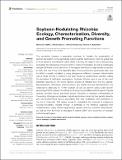Soybean-Nodulating Rhizobia: Ecology, Characterization, Diversity, and Growth Promoting Functions

View/
Date
2022-04-14Author
Nakei, Monica
Venkataramana, Pavithravani
Ndakidemi, Patrick
Metadata
Show full item recordAbstract
The worldwide increase in population continues to threaten the sustainability of agricultural systems since agricultural output must be optimized to meet the global rise in food demand. Sub-Saharan Africa (SSA) is among the regions with a fast-growing population but decreasing crop productivity. Pests and diseases, as well as inadequate nitrogen (N) levels in soils, are some of the biggest restrictions to agricultural production in SSA. N is one of the most important plant-limiting elements in agricultural soils, and its deficit is usually remedied by using nitrogenous fertilizers. However, indiscriminate use of these artificial N fertilizers has been linked to environmental pollution calling for alternative N fertilization mechanisms. Soybean (Glycine max) is one of the most important legumes in the world. Several species of rhizobia from the four genera, Bardyrhizobium, Rhizobium, Mesorhizobium, and Ensifer (formerly Sinorhizobium), are observed to effectively fix N with soybean as well as perform various plant-growth promoting (PGP) functions. The efficiency of the symbiosis differs with the type of rhizobia species, soybean cultivar, and biotic factors. Therefore, a complete understanding of the ecology of indigenous soybean-nodulating rhizobia concerning their genetic diversity and the environmental factors associated with their localization and dominance in the soil is important. This review aimed to understand the potential of indigenous soybean-nodulating rhizobia through a synthesis of the literature regarding their characterization using different approaches, genetic diversity, symbiotic effectiveness, as well as their functions in biological N fixation (BNF) and biocontrol of soybean soil-borne pathogens.
